| Maintenance Service Interval | Maintenance Procedure |
|---|---|
| After each use |
|
Introduction
This rotary-blade, walk-behind lawn mower is intended to be used by residential homeowners or professional, hired operators. It is designed primarily for cutting grass on well-maintained lawns on residential or commercial properties. It is designed to use Toro 60V lithium-ion battery packs. These battery packs are designed to be charged only by Toro 60V lithium-ion battery chargers. Using these products for purposes other than their intended use could prove dangerous to you and bystanders.
Visit www.Toro.com for more information, including safety tips, training materials, accessory information, help finding a dealer, or to register your product.
Whenever you need service, genuine the manufacturer parts, or additional information, contact an Authorized Service Dealer or the manufacturer Customer Service and have the model and serial numbers of your product ready. Figure 1 identifies the location of the model and serial numbers on the product. Write the numbers in the space provided.
Important: With your mobile device, you can scan the QR code on the serial number decal (if equipped) to access warranty, parts, and other product information

Safety-Alert Symbol
The safety-alert symbol (Figure 2) shown in this manual and on the machine identifies important safety messages that you must follow to prevent accidents.

The safety-alert symbol appears above information that alerts you to unsafe actions or situations and is followed by the word DANGER, WARNING, or CAUTION.
DANGER indicates an imminently hazardous situation which, if not avoided, will result in death or serious injury.
WARNING indicates a potentially hazardous situation which, if not avoided, could result in death or serious injury.
CAUTION indicates a potentially hazardous situation which, if not avoided, may result in minor or moderate injury.
This manual uses two other words to highlight information. Important calls attention to special mechanical information and Note emphasizes general information worthy of special attention.
This product complies with all relevant European directives; for details, please see the separate product specific Declaration of Conformity (DOC) sheet.
Safety
IMPORTANT SAFETY
INSTRUCTIONS
Warning
When using electric lawn mowers, basic safety precautions should always be followed to reduce the risk of fire, electric shock, and personal injury, including the following:
Read All Instructions
I. Training
-
The operator of the machine is responsible for any accidents or hazards occurring to others or their property.
-
Do not allow children to use or play with the machine, battery pack, or the battery charger; local regulations may restrict the age of the operator.
-
Do not allow children or untrained people to operate or service this device. Allow only people who are responsible, trained, familiar with the instructions, and physically capable to operate or service the device.
-
Before using the machine, battery pack, and battery charger, read all the instructions and cautionary markings on these products.
-
Become familiar with the controls and proper use of the machine, battery pack, and battery charger.
II. Preparation
-
Keep bystanders, especially children and pets, out of the operating area.
-
Do not operate the machine without all guards and safety devices, such as deflectors and grass catchers, in place and functioning properly on the machine.
-
Inspect the area where you will use the machine and remove all objects that could interfere with the operation of the machine or that the machine could throw.
-
Before using the machine, ensure that the blade, blade bolt, and blade assembly are not worn or damaged. Replace any damaged or unreadable labels.
-
Use only the battery pack specified by Toro. Using other accessories and attachments may increase the risk of injury and fire.
-
Plugging the battery charger into an outlet that is not 100 to 240V can cause a fire or electric shock. Do not plug the battery charger into an outlet other than 100 to 240V. For a different style of connection, use an attachment plug adapter of the proper configuration for the power outlet if needed.
-
Do not use a damaged or modified battery pack or battery charger, which may exhibit unpredictable behavior that results in fire, explosion, or risk of injury.
-
If the supply cord to the battery charger is damaged, contact an Authorized Service Dealer to replace it.
-
Charge the battery pack with only the battery charger specified by Toro. A charger suitable for 1 type of battery pack may create a risk of fire when used with another battery pack.
-
Charge the battery pack in a well-ventilated area only.
-
Follow all charging instructions and do not charge the battery pack outside of the temperature range specified in the instructions. Otherwise, you may damage the battery pack and increase the risk of fire.
-
Dress properly—Wear appropriate clothing, including eye protection; long pants; substantial, slip-resistant footwear (not barefoot or wearing sandals); and hearing protection. Tie back long hair and do not wear loose clothing or loose jewelry that can get caught in moving parts. Wear a dust mask in dusty operating conditions.
III. Operation
-
Contact with the moving blade will cause serious injury. Keep your hands and feet away from the cutting area and all moving parts of the machine. Keep clear of any discharge opening.
-
Using this machine for purposes other than its intended use could prove dangerous to you and bystanders.
-
Disengage the self-propel drive (if equipped) before starting the machine.
-
Do not tilt the machine when starting the motor.
-
Prevent unintentional starting—Ensure that the electric-start button is removed from the electric-start switch before connecting the battery pack and handling the machine.
-
Use your full attention while operating the machine. Do not engage in any activity that causes distractions; otherwise, injury or property damage may occur.
-
Stop the machine, remove the electric-start button, remove the battery pack from the machine, and wait for all movement to stop before adjusting, servicing, cleaning, or storing the machine.
-
Remove the battery pack and electric-start button from the machine whenever you leave it unattended or before changing accessories.
-
Do not force the machine—Allow the machine to do the job better and safer at the rate for which it was designed.
-
Stay alert—Watch what you are doing and use common sense when operating the machine. Do not use the machine while ill, tired, or under the influence of alcohol or drugs.
-
Do not use a battery-operated lawn mower in rain.
-
Operate the machine only in good visibility and appropriate weather conditions. Do not operate the machine when there is the risk of lightning.
-
Use extreme caution when reversing or pulling the machine toward you.
-
Keep proper footing and balance at all times, especially on slopes. Mow across the face of slopes, never up and down. Use extreme caution when changing directions on slopes. Do not mow exceedingly steep slopes. Walk, never run with the machine.
-
Do not direct the discharge material toward anyone. Avoid discharging material against a wall or obstruction; material may ricochet toward you. Stop the blade(s) when crossing surfaces other than grass.
-
Watch for holes, ruts, bumps, rocks, or other hidden objects. Uneven terrain could cause you to lose your balance or footing.
-
Wet grass or leaves can cause serious injury if you slip and contact the blade. Do not mow in wet conditions. Do not mow when it is raining.
-
If the machine strikes an object or starts to vibrate, immediately shut off the machine, remove the electric-start button, remove the battery pack, and wait for all movement to stop before examining the machine for damage. Make all necessary repairs before resuming operation.
-
Stop the machine and remove the electric-start button before loading the machine for hauling.
-
Under abusive conditions, the battery pack may eject liquid; avoid contact. If you accidently come into contact with the liquid, flush with water. If the liquid contacts your eyes, seek medical help. Liquid ejected from the battery pack may cause irritation or burns.
IV. Maintenance and Storage
-
Stop the machine, remove the electric-start button, remove the battery pack from the machine, and wait for all movement to stop before adjusting, servicing, cleaning, or storing the machine.
-
Do not attempt to repair the machine except as indicated in the instructions. Have an Authorized Service Dealer perform service on the machine using identical replacement parts.
-
Wear gloves and eye protection when servicing the machine.
-
Sharpen a dull blade on both edges to maintain balance. Clean the blade and ensure that it is balanced.
-
Replace the blade if it is bent, worn, or cracked. An unbalanced blade causes vibration, which could damage the motor or cause personal injury.
-
When servicing the blade, be aware that the blade can still move even though the power source is off.
-
Check the grass collection bag frequently for deterioration or wear, and replace a worn bag with a Toro [replacement] bag.
-
For best performance, use only genuine Toro replacement parts and accessories. Other replacement parts and accessories could be dangerous, and such use could void the product warranty.
-
Maintain the machine—Keep cutting edges sharp and clean for the best and safest performance. Keep handles dry, clean, and free from oil and grease. Keep guards in place and in working order. Keep blades sharp. Use identical replacement blades only.
-
Check the machine for damaged parts—If there are damaged guards or other parts, determine whether the machine will operate properly. Check for misaligned and binding moving parts, broken parts, mounting, and any other condition that may affect its operation. Unless indicated in the instructions, have an Authorized Service Dealer repair or replace a damaged guard or part.
-
When the battery pack is not in use, keep it away from metal objects such as paper clips, coins, keys, nails, and screws that can make a connection from 1 terminal to another. Shorting the battery terminals may cause burns or a fire.
-
Check the blade and motor mounting bolts frequently for tightness.
-
When you are not using the machine, store it indoors in a dry, secure place out of the reach of children.
-
Do not expose a battery pack or machine to fire or excessive temperature. Exposure to fire or temperature above 130°C (265°F) may cause explosion.
-
CAUTION—A mistreated battery pack may present a risk of fire, explosion, or chemical burn.
-
Do not disassemble the battery pack.
-
Replace the battery pack with a genuine Toro battery pack only; using another type of battery pack may cause a fire or risk of injury.
-
Keep battery packs out of the reach of children and in the original packaging until you are ready to use them.
-
SAVE THESE
INSTRUCTIONS
Safety and Instructional Decals
 |
Safety decals and instructions are easily visible to the operator and are located near any area of potential danger. Replace any decal that is damaged or missing. |
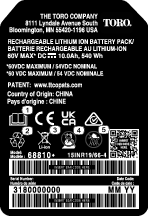


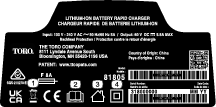
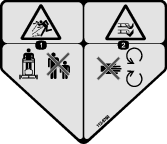




Setup
Important: Remove and discard the protective plastic sheet that covers the motor and any other plastic or wrapping on the machine.
Important: The battery pack is not fully charged when it is purchased. Before using the machine for the first time, refer toCharging the Battery Pack.
Mounting the Battery Charger (Optional)
Parts needed for this procedure:
| Mounting hardware (not included) | 2 |
If desired, mount the battery charger securely on a wall using the wall-mount key holes on the back of the charger.
Mount it indoors (such as a garage or other dry place), near a power outlet, and out of the reach of children.
Refer to Figure 3 for assistance in mounting the charger.
Slide the charger over the appropriately positioned hardware to secure the charger in place (hardware not included).
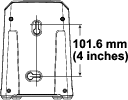
Removing the Cable Guard

Assembling the Lower Handle
Parts needed for this procedure:
| Upper handle assembly | 1 |
| Lower handle | 2 |
| Bolt (5/16 x 1-3/4 inches) | 4 |
| Flange locknut (5/16 inch) | 4 |
| Curved washer | 8 |
Assemble the lower handle as shown in Figure 5.
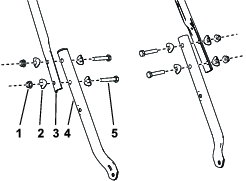
Installing the Handle
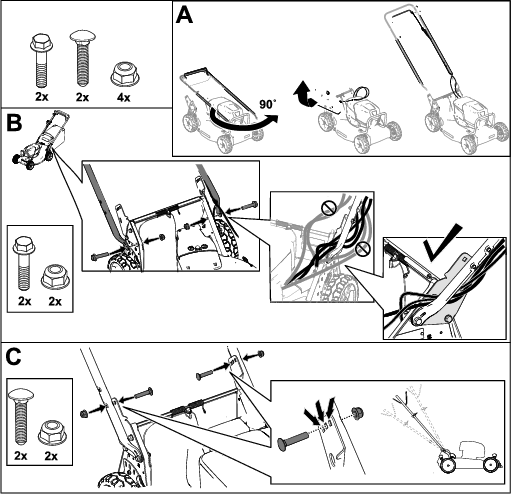
Installing the Cable Guard
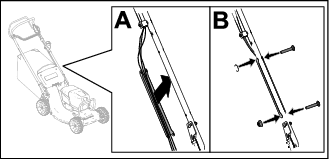
Assembling the Grass Bag
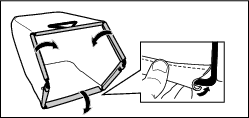
Product Overview
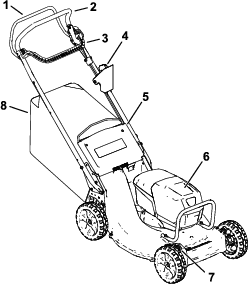

| Model | 68810 | ||
| Battery pack capacity | 10.0 Ah | ||
| 540 Wh | |||
|
Battery manufacturer rating = 60V maximum and 54V nominal. Actual voltage varies with load. |
|||
| Model | 81805 | |
| Type | 60V MAX Lithium-Ion Battery Rapid Charger | |
| Input | 100 to 240V AC ~5.0A, 50/60Hz | |
| Output | 60V DC  5.5A MAX 5.5A MAX |
|
| Charge/store the battery pack at | 5°C (41°F) to 40°C (104°F)* |
| Use the battery pack at | -30°C (-22°F) to 49°C (120°F)* |
| Use the machine at | 0°C (32°F) to 49°C (120°F)* |
*Charging time will increase if you do not charge the battery pack within this range.
Store the machine, battery pack, and battery charger in an enclosed clean, dry area.
Attachments/Accessories
A selection of Toro approved attachments and accessories is available for use with the machine to enhance and expand its capabilities. Contact your Authorized Service Dealer or authorized Toro distributor or go to www.Toro.com for a list of all approved attachments and accessories.
To ensure optimum performance and continued safety certification of the machine, use only genuine Toro replacement parts and accessories. Replacement parts and accessories made by other manufacturers could be dangerous.
Operation
Before Operation
Installing the Battery Pack
Important: Use the battery pack only in temperatures that are within the appropriate range; refer to Specifications.
-
Make sure that the vents on the battery are clear of any dust and debris.
-
Lift up the battery-compartment lid (A of Figure 11).
-
Line up the cavity in the battery pack with the tongue on the machine and slide the battery pack into the compartment until it locks into place (B of Figure 11).
-
Close the battery-compartment lid (C of Figure 11).
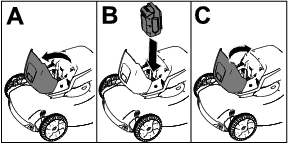
Adjusting the Cutting Height
Warning
Adjusting the cutting-height levers could bring your hands into contact with a moving blade and result in serious injury.
-
Shut off the motor, remove the electric-start button, and wait for all moving parts to stop before adjusting the cutting height.
-
Do not put your fingers under the housing when adjusting the cutting height.
Adjust the cutting height as desired. Set all wheels to the same cutting height (Figure 12).
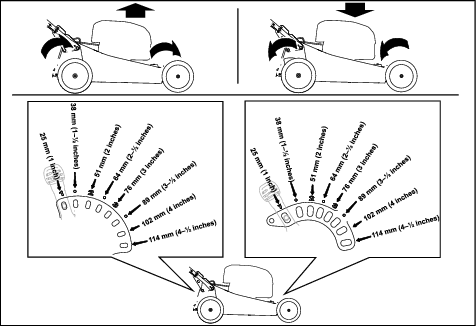
Adjusting the Handle Height
You can raise or lower the handle in 1 of 3 positions that is more comfortable for you (Figure 13).
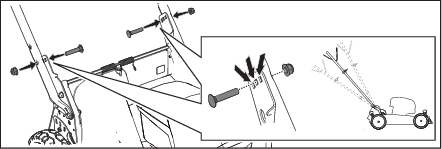
-
Remove both handle bolts and corresponding nuts.
-
Move the handle to the desired height position.
-
Secure the handle with the previously removed bolts and corresponding nuts.
During Operation
Starting the Machine
-
Ensure that the battery pack is installed in the machine; refer to Installing the Battery Pack.
-
Insert the electric-start button into the electric starter switch (A of Figure 14).
-
Squeeze the blade-control bar and hold it to the handle (B of Figure 14).
-
Press the electric-start button and keep it pressed until the motor starts (C of Figure 14).

Recycling the Clippings
Your machine comes from the factory ready to recycle the grass and leaf clippings back into the lawn.
If the grass bag is on the machine, remove it before recycling the clippings. Refer to Removing the Grass Bag.
Bagging the Clippings
Use the grass bag when you want to collect grass and leaf clippings from the lawn.
Warning
A worn grass bag could allow small stones and other similar debris to be thrown toward you or bystanders, resulting in serious personal injury or death.
Check the grass bag frequently. If it is damaged, install a new the manufacturer replacement bag.
Warning
The blades are sharp; contacting the blades can result in serious personal injury.
Shut off the machine and wait for all moving parts to stop before leaving the operating position.
Installing the Grass Bag
-
Shut off the machine and wait for all moving parts to stop.
-
Raise and hold up the rear deflector (A of Figure 15).
-
Remove the rear-discharge plug by pushing in the latch with your thumb and pulling the plug out from the machine (B and C of Figure 15).
-
Install the bag-rod ends into the notches at the base of the handle, and rock the bag back and forth to ensure that the bag-rod ends are seated at the bottom of both notches (D of Figure 15).
-
Lower the rear deflector until it rests on the grass bag.
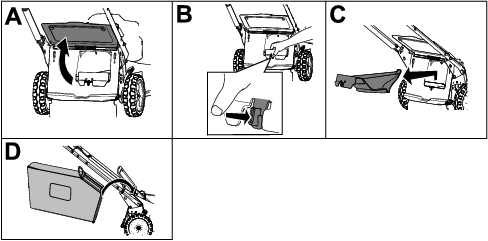
Removing the Grass Bag
Danger
The machine can throw grass clippings and other objects through an opening in the machine housing. Objects thrown with enough force could cause serious personal injury or death to you or to bystanders.
-
Never remove the grass bag and then start the machine without the discharge plug installed on the machine.
-
Never open the rear deflector on the machine when the machine is running.
Operating the Self-Propel Drive
To operate the self-propel drive, squeeze the self-propel drive bar toward the handle and hold it in place (Figure 16).
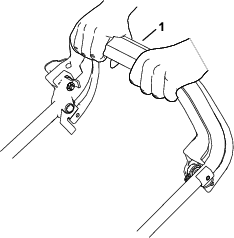
To disengage the self-propel drive, release the self-propel-drive bar.
Note: The machine comes with freewheeling clutches that make it easier to pull the machine rearward. To disengage the clutches, you may need to push the machine forward about 2.5 cm (1 inch) or more after you release the self-propel-drive bar.
Adjusting the Blade Speed
This machine has 2 blade-speed settings: AUTO and MAX.
-
In the AUTO position, the blade speed adjusts automatically for greater efficiency. The machine detects changes in the cutting conditions and increases the blade speed as needed to maintain the quality of cut.
-
In the MAX position, the blade speed remains at the maximum speed at all times.
Turn the key in the key switch to either position to adjust the blade speed setting (Figure 17).
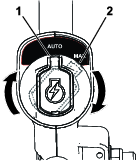
Shutting Off the Machine
-
Release the blade-control bar (A of Figure 18).
-
Remove the electric-start button from the electric starter (B of Figure 18).
-
Remove the battery pack; refer to Removing the Battery Pack from the Machine.
Note: Whenever you are not using the machine, remove the battery pack.
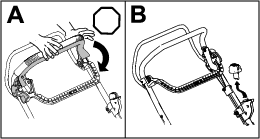
Removing the Battery Pack from the Machine
-
Lift up the battery-compartment lid.
-
Press the battery-pack latch to release the battery pack and remove the battery pack.
-
Close the battery-compartment lid.
Operating Tips
General Mowing Tips
-
Avoid striking solid objects with the blade. Never deliberately mow over any object.
-
For best performance, install a new blade before the cutting season begins.
-
Replace the blade when necessary with a Toro replacement blade.
Cutting Grass
-
Grass grows at different rates at different times of the year. In the summer heat, it is best to cut grass at the 64 mm (2-1/2 inch), 76 mm (3 inch), or 89 mm (3-1/2 inch) cutting-height settings. Cut only about a third of the grass blade at a time. Do not cut below the 64 mm (2-1/2 inch) setting unless the grass is sparse or it is late fall when grass growth begins to slow down. For improved runtime, cut grass at a higher height of cut.
-
When cutting grass over 15 cm (6 inches) tall, first mow at the highest cutting-height setting and a slower speed; then mow again at a lower setting for the best lawn appearance. If the grass is too long and the leaves clump on top of the lawn, the machine may plug and cause the motor to stall.
-
Wet grass and leaves tend to clump on the yard and can cause the machine to plug or the motor to stall. Avoid mowing in wet conditions.
-
Be aware of a potential fire hazard in very dry conditions, follow all local fire warnings, and keep the machine free of dry grass and leaf debris.
-
Alternate the mowing direction. This helps disperse the clippings over the lawn for even fertilization.
If the finished lawn appearance is unsatisfactory, try 1 or more of the following:
-
Sharpen the blade.
-
Mow at a slower pace.
-
Raise the cutting height on your machine.
-
Cut the grass more frequently.
-
Overlap cutting swaths instead of cutting a full swath with each pass.
Cutting Leaves
-
After cutting the lawn, ensure that half of the lawn shows through the cut leaf cover. You may need to make more than a single pass over the leaves.
-
If there are more than 13 cm (5 inches) of leaves on the lawn, mow at a higher cutting height and then again at the desired cutting height.
-
Slow down your mowing speed if the machine does not cut the leaves finely enough.
After Operation
Charging the Battery Pack
Important: The battery pack is not fully charged when you purchase it. Before using the tool for the first time, place the battery pack in the charger and charge it until the LED display indicates the battery pack is fully charged. Read all safety precautions.
Important: Charge the battery pack only in temperatures that are within the appropriate range; refer to Specifications.
Note: At any time, press the battery-charge-indicator button on the battery pack to display the current charge (LED indicators).
-
Ensure that the vents on the battery and charger are clear of any dust and debris.
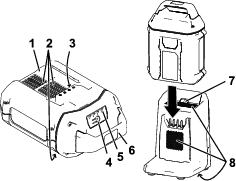
-
Line up the cavity in the battery pack (Figure 19) with the tongue on the charger.
-
Slide the battery pack into the charger until it is fully seated (Figure 19).
-
To remove the battery pack, slide the battery backward out of the charger.
-
Refer to the following table to interpret the LED indicator light on the battery charger.
Indicator light Indicates Off No battery pack inserted Green blinking Battery pack is charging Green Battery pack is charged Red Battery pack and/or battery charger is over or under the appropriate temperature range Red blinking Battery pack charging fault*
*Refer to for more information.
Important: The battery can be left on the charger for short periods between uses.If the battery will not be used for longer periods, remove the battery from the charger; refer to Before storage.
Cleaning under the Machine
To ensure the best performance, keep the underside of the machine clean and clean under the machine soon after you have completed mowing. Be especially careful to keep the kickers free of debris (Figure 20).

Washing Method
Warning
The machine may dislodge material from under the machine.
-
Wear eye protection.
-
Stay in the operating position (behind the handle) while the machine is running.
-
Do not allow bystanders in the area.
-
Lower the machine to its lowest cutting-height setting.
-
Move the machine to a paved level surface.
-
Turn on the machine and engage the blade.
-
Hold a garden hose at handle level and spray a stream of water in front of the right, rear wheel (Figure 21).
Note: The water will splash into the path of the blade, cleaning out the clippings.

-
When no more clippings come out, stop the water and move the machine to a dry area.
-
Run the motor for a few minutes to dry the underside of the machine.
Scraping Method
If washing does not remove all debris from under the machine, scrape it clean.
-
Shut off the machine and wait for all moving parts to stop.
-
Remove the electric-start button and the battery from the machine.
-
Tip the machine onto its side.
-
Remove the dirt and grass clippings with a scraper. Avoid any burrs or sharp edges.
-
Return the machine to the operating position.
Maintenance
Recommended Maintenance Schedule(s)
| Maintenance Service Interval | Maintenance Procedure |
|---|---|
| After the first 25 hours |
|
| Before each use or daily |
|
| After each use |
|
| Every 40 hours |
|
| Every 50 hours |
|
| Every 100 hours |
|
Adjusting the Self-Propel Drive
If the machine is new, does not self-propel, or it tends to creep forward, adjust the drive cable.
-
Move the machine outside and onto a paved surface near a solid wall to safely prevent the machine from moving forward while the motor is turned on.
-
Position the machine with the front tires against the wall.
Note: Ensure that the area is well ventilated and clear of debris that could be thrown by the machine.
-
Start the motor; refer to Starting the Machine.
-
Pull the self-propel-drive bar to the handle.
Note: The wheels should start to turn as the self-propel-drive bar just touches the handle.
-
Shut off the motor.
-
If you must adjust the machine, do the following:
-
If the wheels do not spin when you engage the self-propel-drive bar, the traction belt is too loose. Rotate the wheel-drive-control knob (Figure 22) clockwise 1 turn and repeat steps 3 through 5.
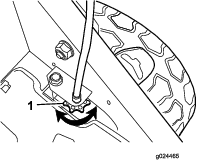
-
If the wheels spin before you fully engage the self-propel-drive bar, the traction belt is too tight. Rotate the wheel-drive-control knob (Figure 22) counterclockwise 1 turn and repeat steps 3 through 5.
-
-
For a new traction belt, rotate the drive-cable-adjustment knob clockwise 1 additional turn to allow for the normal stretching of the belt during the break-in period.
Note: You can skip this step if you are adjusting a used belt.
Maintaining the Blade
Always mow with a sharp blade. A sharp blade cuts cleanly and without tearing or shredding the grass blades.
-
Shut off the machine and wait for all moving parts to stop.
-
Remove the battery pack; refer to Removing the Battery Pack from the Machine.
-
Tip the machine onto its side as shown in Figure 23.
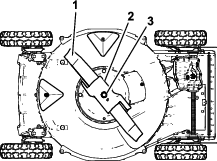
Inspecting the Blade
| Maintenance Service Interval | Maintenance Procedure |
|---|---|
| Before each use or daily |
|
Carefully examine the blade for sharpness and wear, especially where the flat and the curved parts meet (Figure 24A). Because sand and abrasive material can wear away the metal that connects the flat and curved parts of the blade, check the blade before using the machine. If you notice a slot or wear (Figure 24B and Figure 24C), replace the blade; refer to Removing the Blade.
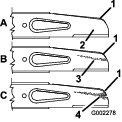
Note: For the best performance, install a new blade before the mowing season begins. During the year, file down any small nicks to maintain the cutting edge.
Danger
A worn or damaged blade can break, and a piece of the blade could be thrown toward you or bystanders, resulting in serious personal injury or death.
-
Inspect the blade periodically for wear or damage.
-
Replace a worn or damaged blade.
Inspecting the Accelerator
| Maintenance Service Interval | Maintenance Procedure |
|---|---|
| Before each use or daily |
|
Carefully examine the accelerator for excessive wear (Figure 25). Because sand and abrasive material can wear away the metal (especially in the area shown as item 2 in Figure 25), check the accelerator before using the machine. If you notice that a tab on the accelerator has been worn down to a sharp edge or there is a crack, replace the accelerator.

Warning
A worn or damaged accelerator can break, and a piece of the accelerator could be thrown at you or bystanders, resulting in serious personal injury or death.
-
Inspect the accelerator periodically for wear or damage.
-
Replace a worn or damaged accelerator.
Removing the Blade
-
Grasp the end of the blade using a rag or a thickly padded glove.
-
Remove the blade bolt, the lock washer, the accelerator, and the blade (Figure 24).
Sharpening the Blade
| Maintenance Service Interval | Maintenance Procedure |
|---|---|
| Every 50 hours |
|
File the top side of the blade to maintain its original cutting angle (Figure 26A) and inner cutting edge radius (Figure 26B). The blade will remain balanced if you remove the same amount of material from both cutting edges.

Balancing the Blade
-
Check the balance of the blade by placing the center hole of the blade over a nail or screwdriver shank clamped horizontally in a vise (Figure 27).

Note: You can also check the balance using a commercially manufactured blade balancer.
-
If either end of the blade rotates downward, file that end (not the cutting edge or the end near the cutting edge) until neither end of the blade drops.
Installing the Blade
-
Install a sharp, balanced Toro blade, the accelerator, the lock washer, and the blade bolt. The sail of the blade must point toward the top of the mower housing for proper installation.
Note: Torque the blade bolt to 82 N∙m (60 ft-lb).
Warning
Operating the machine without the accelerator in place can cause the blade to flex, bend, or break, resulting in serious injury or death to you or to bystanders.
Do not operate the machine without the accelerator in place.
-
Return the machine to the operating position.
Cleaning the Wheels
| Maintenance Service Interval | Maintenance Procedure |
|---|---|
| Every 40 hours |
|
-
Remove the rear wheels and clean any debris from the wheel-gear area.
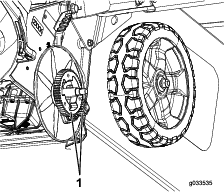
-
After cleaning, apply a small amount of anti-seize compound to the gears.
Note: If you operate the machine in extreme conditions, cleaning the wheels more frequently than recommended will increase gear life.
Note: To prevent damage to the bearing seals, do not use a high-pressure water spray on the bearings.
Preparing the Battery Pack for Recycling
Important: Upon removal, cover the terminals of the battery pack with heavy-duty adhesive tape. Do not attempt to destroy or disassemble the battery pack or remove any of its components.
Contact your local municipality or your authorized Toro distributor for more information on how to responsibly recycle the battery.
Storage
To prepare the machine for off-season storage, perform the recommended maintenance procedures; refer to .
Always shut off the machine, wait for all moving parts to stop, and allow the machine to cool before adjusting, servicing, cleaning, or storing it.
Store the machine in a cool, clean, dry place. Cover the machine to keep it clean and protected.
Important: Store the machine, battery pack, and charger only in temperatures that are within the appropriate range; refer to Specifications.
Important: If you are storing the battery pack for the off-season, charge it until 2 or 3 LED indicators turn green on the battery. Do not store a fully charged or fully depleted battery. When you are ready to use the machine again, charge the battery pack until the left indicator light turns green on the charger or all 4 LED indicators turn green on the battery.
-
Disconnect the machine from the power supply (i.e., remove the battery pack) and check for damage after use.
-
Do not store the machine with the battery pack installed.
-
Store the machine, battery pack, and battery charger in an enclosed, clean, dry well-ventilated place that is inaccessible to children.
-
Keep the machine, battery pack, and battery charger away from corrosive agents such as garden chemicals and de-icing salts.
-
To reduce the risk of serious personal injury, do not store the battery pack outside or in vehicles.
-
Remove grass clippings, dirt, and grime from the external parts of the motor, the shrouding, and the top of the mower housing.
-
Clean under the machine; refer to Cleaning under the Machine.
-
Check the condition of the blade; refer to Inspecting the Blade.
-
Check the condition of the accelerator; refer to Inspecting the Accelerator.
-
Tighten all nuts, bolts, and screws.
-
Touch up all rusted or chipped paint surfaces with paint available from an Authorized Service Dealer.
Troubleshooting
Perform only the steps described in these instructions. All further inspection, maintenance, and repair work must be performed by an authorized service center or a similarly qualified specialist if you cannot solve the problem yourself.
| Problem | Possible Cause | Corrective Action |
|---|---|---|
| The machine does not run or does not run continuously. |
|
|
| The machine does not reach full power. |
|
|
| The machine or motor is producing excessive vibration or noise. |
|
|
| The is an uneven cutting pattern. |
|
|
| The discharge chute plugs up. |
|
|
| The machine does not self-propel. |
|
|
| The battery pack loses charge quickly. |
|
|
| The battery charger is not working. |
|
|
| The LED indicator light on the battery charger is red. |
|
|
| The LED indicator light on the battery charger is blinking red. |
|
|